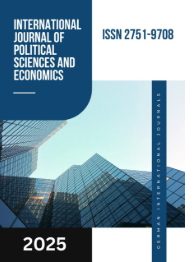FREQUENCY OF MYCOSES IN PATIENTS WITH DRUG-RESISTANT PULMONARY TUBERCULOSIS
DOI:
https://doi.org/10.55640/Keywords:
tuberculosis, mycoses, HIV patients, frequencyAbstract
One of the current problems of phthisiology is the high incidence of tuberculosis among HIV-infected patients. The prevalence of these diseases in the same population groups causes their frequent association with each other, which makes the prognosis of combined pathology extremely unfavorable.
The emergence of multiple drug resistance in Mycobacterium tuberculosis has become a serious threat to the effectiveness of anti-tuberculosis programs in many countries of the world [ 1] . The growth of the HIV epidemic is also reflected in the situation with drug-resistant tuberculosis, which is also associated with impaired anti-tuberculosis immunity [4]. The high frequency of multiple drug resistance in Mycobacterium tuberculosis (resistance to the most effective anti-tuberculosis drugs isoniazid and rifampicin ) clearly and directly correlates with the prevalence of HIV infection [3]. Drug resistance in Mycobacterium tuberculosis is one of the main factors limiting the effectiveness of anti-tuberculosis therapy.
The prevalence of resistant forms of Mycobacterium tuberculosis in newly diagnosed patients with tuberculosis and HIV infection is higher than in patients with tuberculosis without HIV infection (2% versus 0.4%).
References
1.Bartlett JG, Gallant JE. Medical management of HIV infection. Baltimore, MD, Johns Hopkins University School of Medicine, 2000-2001.
2.French N, Nakiyingi J, Carpenter LM, et al. 23-valent pneumococcal polysaccharide vaccine in HIV-1 infected Ugandan adults: double-blind, randomized and placebo controlled trial. Lancet, 2000, 355: 2106–2111.
3.World Health Organization. Improving child health. IMCI: the integrated approach. Rev.2. Geneva (WHO/CHD/97.12) (www.who.int/child-adolescent-health) 1997.
4.Kovacs J. A., Masur H.Prophylaxis against opportunistic infections in patients with human immunodeficiency virus infection. New England journal of medicine 2000, 342: 1416–1429.
5.World Health Organization. Management of the child with a serious infection or severe malnutrition. Guidelines for care at the first-referral level in developing countries. Geneva, 2000 (WHO/FCH/CAH/00.1).
6.Provisional WHO/UNAIDS secretariat recommendations on the use of cotrimoxazole prophylaxis in adults and children living with HIV/AIDS in Africa. Geneva, 2000 ,WHO /UNAIDS.
7.Wiktor SZ, Sassan-Morokro M, Grant AD, et al. Efficacy of trimethoprimsulphamethoxazole prophylaxis to decrease morbidity and mortality in HIV-1infected patients with tuberculosis in Abidjan, Cote d'Ivoire: a randomized controlled trial. Lancet 1999, 353: 1469–1475.
8.World Health Organization.Guidelines for the clinical management of HIV infection in adults. Geneva, 1991.
9.World Health Organization.Guidelines for the clinical management of HIV infection in children. Geneva, 1993.
10.World Health Organization. AIDS in Africa: a manual for physicians. Geneva, 1992.
11.World Health Organization.Guidelines for the management of sexually transmitted infections. Geneva, 2003.
12.World Health Organization. Improving child health. IMCI: the integrated approach. Geneva , 1997 (WHO/CHD/97.12 Rev.2)
13.M.P. Vorozhtsova et al. 2005; M.O. Mayorova et al. 2012; Sidorenko N.Yu. 2013
14. O.V. Lovacheva et al . 2005; O.F. Rabinovich et al . 2011; A.V. Lipnitsky et al. 2013
15.Belyaeva V.V., Kravchenko A.V. 2005; V.G. Kanestri et al . 2006; V.N. Zimina et al . 2012
16.E.M. Bagorodskaya et al . 2012; I.A. Vasilyeva et al . 2012
Downloads
Published
Issue
Section
License

This work is licensed under a Creative Commons Attribution 4.0 International License.
Authors retain the copyright of their manuscripts, and all Open Access articles are disseminated under the terms of the Creative Commons Attribution License 4.0 (CC-BY), which licenses unrestricted use, distribution, and reproduction in any medium, provided that the original work is appropriately cited. The use of general descriptive names, trade names, trademarks, and so forth in this publication, even if not specifically identified, does not imply that these names are not protected by the relevant laws and regulations.







